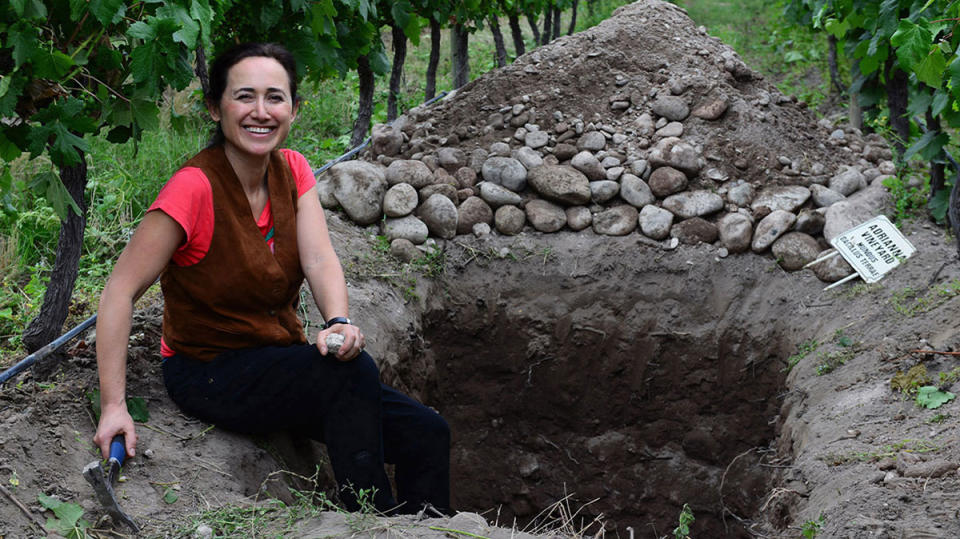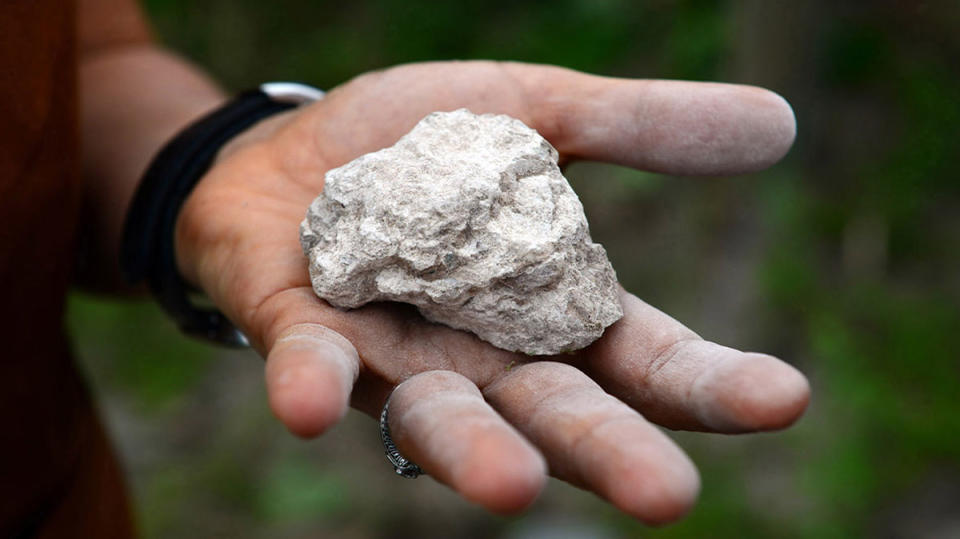This Argentine Winery Believes It’s Worthy of Grand Cru Status—and It’s Using Science to Prove It

- Oops!Something went wrong.Please try again later.
Winemakers around the world are known to refer to their vineyards as grand cru sites regardless of whether they are using the term correctly or not. French for “growth,” cru designates an excellent vineyard site and considers soil, climate, altitude, and aspect. In France and France alone the term grand cru refers to the best vineyards or estates, but if fourth-generation vintner Laura Catena has her way, that designation would extend all the way to South America. The managing director at Argentina’s Catena Zapata, wants her family’s high-altitude Adrianna vineyard, in the Gualtallary subzone of Mendoza’s Uco Valley, to be considered on equal footing to the grand cru vineyards of France—and she’s coming with the science to back it up.
“Our Adrianna Vineyard White Bones Chardonnay has the kind of minerality and purity of aromas that make Chablis and Puligny Montrachet so sought after,” Catena tells Robb Report. “They are the wine equivalent of oysters and caviar.” Named for its fractured limestone soils that have the appearance of crumbled bones as well as fossilized animal remains found among the vines, the White Bones parcel is 5.43 acres and sits at an altitude of 4,757 feet. The Adrianna vineyard takes its moniker from Catena’s younger sister, Adrianna, who was at home with their parents when the vineyard was first planted. A scientist by nature, Catena obtained her B.S. in biology at Harvard University and a degree in medicine from Stanford; and for over 25 years has been a part-time emergency medicine physician in San Francisco.
More from Robb Report
Robb Report's Napa Valley Wine Club Has 3 Stellar New Reds on the Way
Robert Mondavi's Grandson Can't Use the Family Name, but He's Still Crafting Excellent Napa Cabs
Catena’s father, Nicolás, first settled on the Adrianna site in 1992 after renowned French vintner Jacques Lurton said that the family’s Catena Malbec tasted like a Cabernet from the Languedoc, a warm French region known at the time for an over-ripe style of red wine. Nicolás Catena’s search for a cooler vineyard yielded what remains to this day the highest-altitude site in Mendoza, which sits at an average of 5,000 feet; it is planted with cuttings of Chardonnay and Cabernet Sauvignon from France and Malbec from a 70-year-old family vineyard in Mendoza. Today it is divided into 11 distinct lots that are subdivided into parcels from which single vineyard wines are made; besides the White Bones Chardonnay, Adrianna Vineyard is also the home of White Stones Chardonnay, Fortuna Terrae Malbec, River Malbec, and Mundus Bacillus Tarrea Malbec. Pinot Noir, Cabernet Franc, and Semillon are planted there as well.

Altitude and limestone soils alone do not produce great wine; the differences within Adrianna, besides variations in vineyard height, lie in the top layer of soil, which is mainly alluvial, caused by an ancient river that ran through here, and eolic, formed by wind. Years of soil study have shown that there is a paradox at work here, as the rocky soils filled with limestone and chalk have excellent drainage but at the same time retain water for longer periods of time than gravel but less than clay. One thing is certain: All of the wines made here exhibit striking minerality. Catena first started studying the soils in earnest over a decade ago, with an average of five pits dug per hectare to see what lies below the surface. There are now 70 pits per hectare (2.47 acres) throughout Adrianna, which has been further divided into almost 300 lots, which are picked, vinified, and aged separately. Since the founding of the winery’s research department in the 1990s, when Laura began working with her father, they produce over 1,000 microvinifications each year in order to study the polyphenols, tannins, and acidity based on variations in altitude, soil, and sunlight exposure.
“We have studied the soil composition, the root depth and weight, the pruning weight, the microbes in the soil and the tannins and aromas in the wine,” Catena says. “We have proven that different soils have important impacts on flavor. What we are still researching though is exactly why one soil or another results in a different flavor profile.”
Catena is continuing to research why plants behave differently; for example, roots are deeper in certain locations. “The rocky soils have the deepest roots, possibly related to searching for water and nutrients,” she says. Work is also being done to understand why the microbial populations in the soil are different, and why the acidity and tannins in the wine vary. “What we do know is that the same plant selection, Chardonnay, planted at the same altitude, getting the same viticultural and winemaking treatments in two different soils will have very different flavors and aromas,” she says. Catena refers to this as the “terroir fingerprint.”
Planted in an eons-old riverbed covered with small, white, oval stones, the River parcel benefits from the stones’ heating and cooling properties; they absorb heat during the hot, sunny days, and then amplify nighttime coolness, preserving freshness and acidity in the Malbec grown there. Fortuna Terrae translates from Latin as “fortune of the earth,” as the grapes cultivated there have the advantage of its deep loamy soils and biodiversity, while Mundus Bacillus Terrae refers to the wide range of microorganisms that help the vines absorb nutrients.

Catena does not rely on science alone; she helps spread the word about her family’s special patch of earth through comparative tastings with herself and a master sommelier for wine buyers, sommeliers, and journalists, showcasing her single-lot Adrianna Vineyard Chardonnays alongside wines from Chablis and Puligny-Montrachet and her Malbecs alongside Pinot Noir from Oregon, a Super Tuscan, and a well-known Napa Cabernet Sauvignon. Wines from the Adrianna Vineyard have received eight 100-point scores from a variety of international publications as well as a multitude of scores in the high 90s, and Catena Zapata 2019 Adrianna Vineyard Fortuna Terrae Malbec was Robb Report’s Best of the Best Argentine wine in 2023. Last year, Catena Zapata was voted number one in the world at the World’s Best Vineyards ceremony in Rioja, Spain.
Catena’s 2020 book, Gold in the Vineyards, highlights the stories and the soil and climate secrets behind some of the most famous wines in the world, including Domaines Barons de Rothschild Lafite, Domaine de la Romanée-Conti, Harlan Estate, and her family’s Catena Zapata Adrianna Vineyard offerings. In her book, she notes that families are generally behind the world’s most celebrated wines, “because families have the patience to do the trial and error that it takes to find a magical place that will yield a wine that is unforgettable and can age for many decades,” she says, adding, “I believe that the term [grand cru] can be used to describe a particularly special and unforgettable wine that comes from a defined, small parcel of land.” While Catena’s claims of Adrianna as a grand cru site has science on its side, only time will tell if the wine world regards the vineyard among the world’s best.
Best of Robb Report
Why a Heritage Turkey Is the Best Thanksgiving Bird—and How to Get One
The 10 Best Wines to Pair With Steak, From Cabernet to Malbec
Sign up for Robb Report's Newsletter. For the latest news, follow us on Facebook, Twitter, and Instagram.

